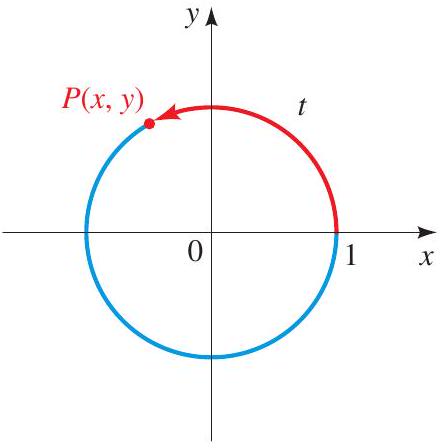
The unit circle is the circle of radius 1 centered at \((0,0)\). The equation of the unit circle is \(x^{2}+y^{2}=1\).
The terminal point \(P(x, y)\) determined by the real number \(t\) is the point obtained by traveling counterclockwise a distance \(t\) along the unit circle, starting at \((1,0)\).
Special terminal points are listed in Table 5.1.1.

The reference number associated with the real number \(t\) is the shortest distance along the unit circle between the terminal point determined by \(t\) and the \(x\)-axis.
Let \(P(x, y)\) be the terminal point on the unit circle determined by the real number \(t\). Then for nonzero values of the denominator the trigonometric functions are defined as follows.
The trigonometric functions have the following values at the special values of \(t\).
| \(\boldsymbol{t}\) | \(\boldsymbol{\operatorname { s i n } t}\) | \(\boldsymbol{\operatorname { c o s }} \boldsymbol{t}\) | \(\boldsymbol{\operatorname { t a n }} \boldsymbol{t}\) | \(\boldsymbol{\operatorname { c s c }} \boldsymbol{t}\) | \(\sec t\) | \(\boldsymbol{\operatorname { c o t }} \boldsymbol{t}\) |
|---|---|---|---|---|---|---|
| 0 | 0 | 1 | 0 | - | 1 | - |
| \(\frac{\pi}{6}\) | \(\frac{1}{2}\) | \(\frac{\sqrt{3}}{2}\) | \(\frac{\sqrt{3}}{3}\) | 2 | \(\frac{2 \sqrt{3}}{3}\) | \(\sqrt{3}\) |
| \(\frac{\pi}{4}\) | \(\frac{\sqrt{2}}{2}\) | \(\frac{\sqrt{2}}{2}\) | 1 | \(\sqrt{2}\) | \(\sqrt{2}\) | 1 |
| \(\frac{\pi}{3}\) | \(\frac{\sqrt{3}}{2}\) | \(\frac{1}{2}\) | \(\sqrt{3}\) | \(\frac{2 \sqrt{3}}{3}\) | 2 | \(\frac{\sqrt{3}}{3}\) |
| \(\frac{\pi}{2}\) | 1 | 0 | - | 1 | - | 0 |
| \(\pi\) | 0 | -1 | 0 | - | -1 | - |
| \(\frac{3 \pi}{2}\) | -1 | 0 | - | -1 | - | 0 |
An identity is an equation that is true for all values of the variable. The basic trigonometric identities are as follows.
A function \(f\) is periodic if there is a positive number \(p\) such that \(f(x+p)=f(x)\) for every \(x\). The least such \(p\) is called the period of \(f\). The sine and cosine functions have period \(2 \pi\), and the tangent function has period \(\pi\).
The graphs of sine and cosine have amplitude 1 and period \(2 \pi\).
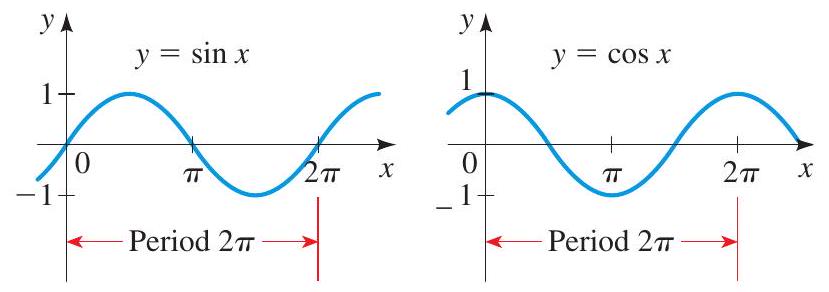
Amplitude 1, Period \(2 \pi\)
Graphs of Transformations of Sine and Cosine | Section 5.3
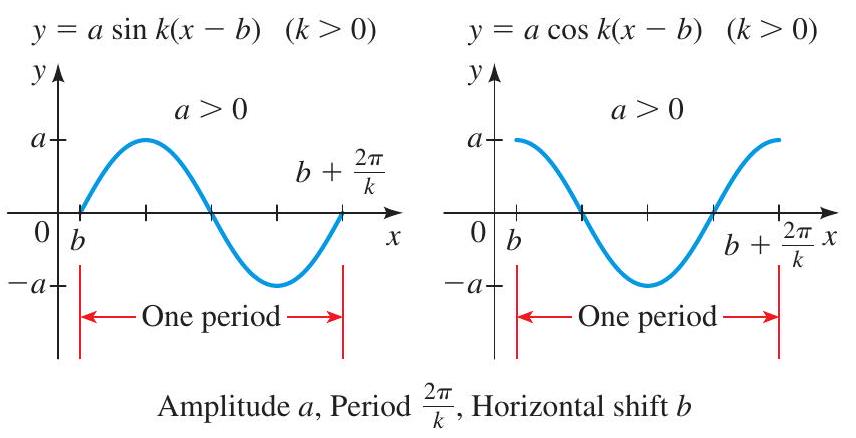
An appropriate interval on which to graph one complete period is \([b, b+(2 \pi / k)]\).
These functions have period \(\pi\).
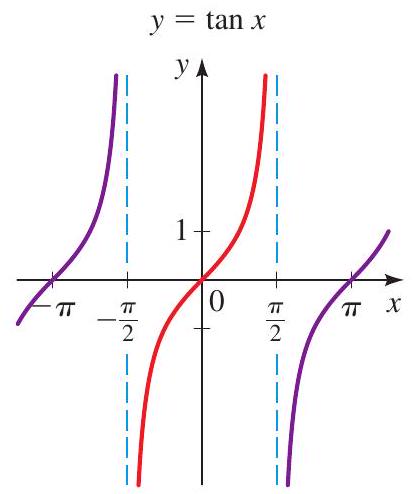 \(y=\cot x\)
\(y=\cot x\)
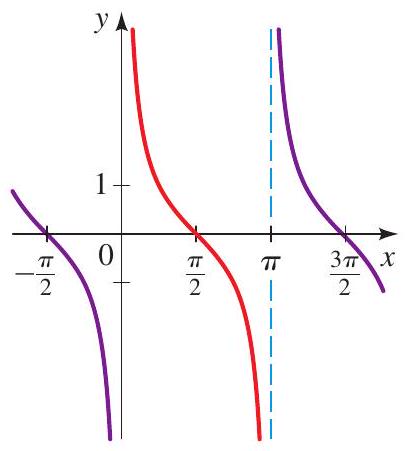
To graph one period of \(y=a \tan k x\), an appropriate interval is \(\left(-\frac{\pi}{2 k}, \frac{\pi}{2 k}\right)\). To graph one period of \(y=a \cot k x\), an appropriate interval is \(\left(0, \frac{\pi}{k}\right)\).
These functions have period \(2 \pi\).
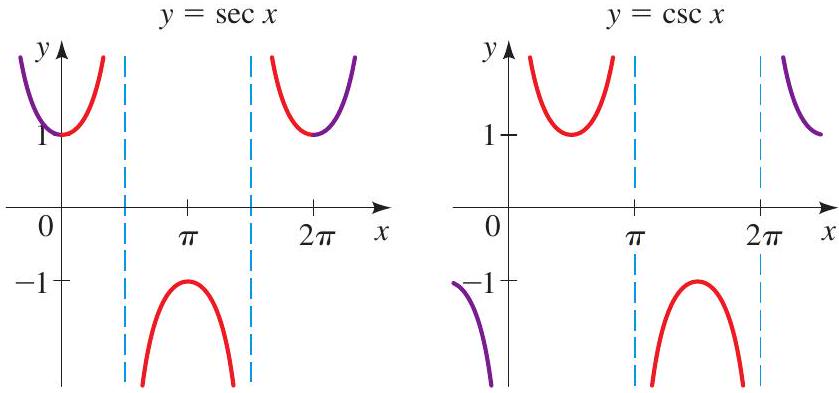
To graph one period of \(y=a \sec k x\) or \(y=a \csc k x\), an appropriate interval is \(\left(0, \frac{2 \pi}{k}\right)\).
Inverse functions of the trigonometric functions have the following domain and range.
| Function | Domain | Range |
|---|---|---|
| \(\sin ^{-1}\) | \([-1,1]\) | \(\left[-\frac{\pi}{2}, \frac{\pi}{2}\right]\) |
| \(\cos ^{-1}\) | \([-1,1]\) | \([0, \pi]\) |
| \(\tan ^{-1}\) | \((-\infty, \infty)\) | \(\left(-\frac{\pi}{2}, \frac{\pi}{2}\right)\) |
The inverse trigonometric functions are defined as follows.
Graphs of these inverse functions are shown below.
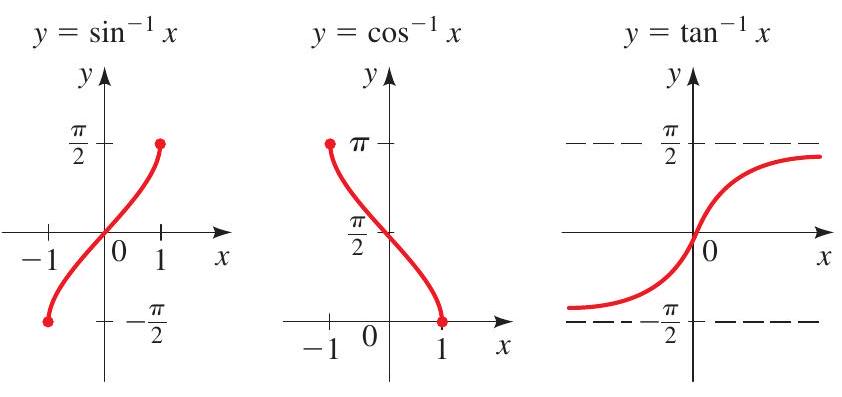
An object is in simple harmonic motion if its displacement \(y\) at time \(t\) is modeled by \(y=a \sin \omega t\) or \(y=a \cos \omega t\). In this case the amplitude is \(|a|\), the period is \(2 \pi / \omega\), and the frequency is \(\omega /(2 \pi)\).
An object is in damped harmonic motion if its displacement \(y\) at time \(t\) is modeled by \(y=k e^{-c t} \sin \omega t\) or \(y=k e^{-c t} \cos \omega t, c>0\). In this case \(c\) is the damping constant, \(k\) is the initial amplitude, and \(2 \pi / \omega\) is the period.
Any sine curve can be expressed in the following equivalent forms:
The phase (or phase angle) \(b\) is the initial angular position of the motion. The number \(b / k\) is also called the lag time \((b>0)\) or lead time \((b<0)\).
Suppose that two objects are in harmonic motion with the same period modeled by
The phase difference between \(y_{1}\) and \(y_{2}\) is \(b-c\). The motions are "in phase" if the phase difference is a multiple of \(2 \pi\); otherwise, the motions are "out of phase."